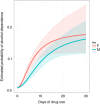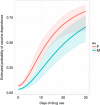Transitioning from First Drug Use to Dependence Onset: Illustration of a Multiparametric Approach for Comparative Epidemiology
- PMID: 26174595
- PMCID: PMC4707832
- DOI: 10.1038/npp.2015.213
Transitioning from First Drug Use to Dependence Onset: Illustration of a Multiparametric Approach for Comparative Epidemiology
Abstract
Studying transitions from first drug use (DU) to drug dependence (DD) onset, we estimate a parsimonious set of parameters based on epidemiological data, with plans for future longitudinal research on newly incident drug users and with tracking of self-administration frequencies and DD clinical features. Our expectation is a distinctive sigmoid pattern with one asymptote for lower DD probability (when DU is insubstantial), upturning slopes of DD risk beyond a middle value (PD50), and eventual higher DD risk asymptotes at higher DU frequencies. We illustrate this novel approach using cross-sectional data from the United States National Surveys on Drug Use and Health, 2002-2011. Empirical DD probabilities observed soon after newly incident use are estimated across DU frequency values, using parametric Hill functions and four governing parameters for differential comparison across drugs and DU subgroups. Among drug subtypes considered, cocaine shows larger estimates, especially among females (estimated P(min)=7% for females vs 3% for males; p<0.001), for whom PD50 is shorter by 8 days of use (p=0.027), conditional on the same rate of use in the past 30 days. Clear alcohol male-female differences also are observed (eg, female PD50 < male PD50; p=0.002). Although based on cross-sectional snapshots soon after DU onset, this novel multiparametric statistical approach for comparative epidemiological DD research creates new opportunities in planned studies with prospectively gathered longitudinal data. The cross-sectional estimates provide starting values needed to plan future longitudinal research programs on transitions from initial DU until formation of a DD syndrome.
Figures




Similar articles
-
Estimated probability of becoming a case of drug dependence in relation to duration of drug-taking experience: a functional analysis approach.Int J Methods Psychiatr Res. 2017 Jun;26(2):e1513. doi: 10.1002/mpr.1513. Epub 2016 Jun 29. Int J Methods Psychiatr Res. 2017. PMID: 27356948 Free PMC article.
-
Inter-relationships Linking Probability of Becoming a Case of Nicotine Dependence With Frequency of Tobacco Cigarette Smoking.Nicotine Tob Res. 2016 Dec;18(12):2278-2282. doi: 10.1093/ntr/ntw159. Epub 2016 Sep 7. Nicotine Tob Res. 2016. PMID: 27613940 Free PMC article.
-
Male-female differences in the risk of progression from first use to dependence upon cannabis, cocaine, and alcohol.Drug Alcohol Depend. 2007 Jan 12;86(2-3):191-8. doi: 10.1016/j.drugalcdep.2006.06.003. Epub 2006 Oct 9. Drug Alcohol Depend. 2007. PMID: 17029825
-
Alcohol and cocaine abuse. A comparison of epidemiology and clinical characteristics.Recent Dev Alcohol. 1992;10:115-28. Recent Dev Alcohol. 1992. PMID: 1317046 Review.
-
Developments in the epidemiology of drug use and drug use disorders.Am J Psychiatry. 2005 Aug;162(8):1494-502. doi: 10.1176/appi.ajp.162.8.1494. Am J Psychiatry. 2005. PMID: 16055770 Review.
Cited by
-
Sex-based differences in multidimensional clinical assessments of early-abstinence crack cocaine users.PLoS One. 2019 Jun 21;14(6):e0218334. doi: 10.1371/journal.pone.0218334. eCollection 2019. PLoS One. 2019. PMID: 31226126 Free PMC article.
-
Shaping vulnerability to addiction - the contribution of behavior, neural circuits and molecular mechanisms.Neurosci Biobehav Rev. 2018 Feb;85:117-125. doi: 10.1016/j.neubiorev.2017.05.019. Epub 2017 May 29. Neurosci Biobehav Rev. 2018. PMID: 28571877 Free PMC article. Review.
-
Cocaine and Marijuana Polysubstance Use and Cocaine Use Disorder: Investigating Mediated Effects through Patterns of Cocaine Use.J Dual Diagn. 2021 Jan-Mar;17(1):23-33. doi: 10.1080/15504263.2020.1849887. Epub 2020 Dec 10. J Dual Diagn. 2021. PMID: 33300839 Free PMC article.
-
Onset of alcohol use disorder among alcohol initiates by race/ethnicity.Alcohol. 2021 Dec;97:13-21. doi: 10.1016/j.alcohol.2021.08.002. Epub 2021 Aug 16. Alcohol. 2021. PMID: 34411688 Free PMC article.
-
Sex differences in brain regional homogeneity during acute abstinence in cocaine use disorder.Addict Biol. 2022 May;27(3):e13177. doi: 10.1111/adb.13177. Addict Biol. 2022. PMID: 35470550 Free PMC article.
References
-
- Ahmed SH, Koob GF (2005). Transition to drug addiction: a negative reinforcement model based on an allostatic decrease in reward function. Psychopharmacology (Berl) 180: 473–490. - PubMed
-
- American Psychiatric Association (2013) Diagnostic and Statistical Manual of Mental Disorders. American Psychiatric Association: Washington, DC. Available at <http://dsm.psychiatryonline.org/doi/book/10.1176/appi.books.978089042559....
-
- Anthony JC, Warner LA, Kessler RC (1994). Comparative epidemiology of dependence on tobacco, alcohol, controlled substances, and inhalants: basic findings from the National Comorbidity Survey. Exp Clin Psychopharmacol 2: 244–268.
Publication types
MeSH terms
Grants and funding
LinkOut - more resources
Full Text Sources
Other Literature Sources
Medical
Molecular Biology Databases
Miscellaneous

